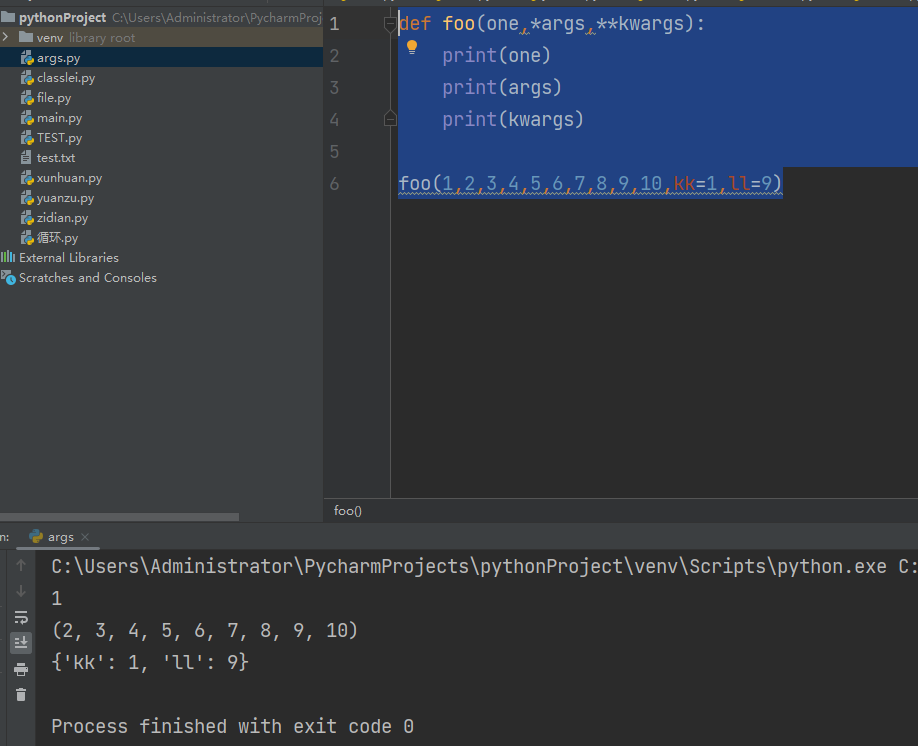列表常用方法
append 增加一个元素
a.append('aaaa')
extend 增加多个
a.extend([1,2,3,4,5,6])
index检索,个人理解类似于find
print(a.index("is"))
inset 指定位置插入
a.insert(2,"aasdfasdf")
pop 删除 把列表中最后一个元素删除,还会把删除的元素返回回来 (基本不怎么用这个)
a.pop()
count计次
a.count('a')
count搭配remove循环删除列表中的某个数
for i in range(a.count(1)):
a.remove(1)
print(a)
reverse 反转,把列表中的元素反转一下
a.reverse()
sort 排序 这个暂时不会,后面用到来补充
元组
感觉基本用不到,列表用的多
a=(1,2,3,34,5,6,7,7) print(a.count(1)) print(a.index(1))
字典
clear 清空
a.clear() print(a)
get 取出元素
print(a.get('python'))
items 列出键值对
print(a.items())
update 更新
a.update({"python":100})
print(a)
函数
类的属性和方法
面向对象,
class testone:
#共有变量写法
a = 1
#私有变量写法
__a =2
def test1(self):
print("内部变量" ,self.__a)
test111 = testone()
test111.test1()
两个循环中常用的方法
enumerate 循环的时候自带计数
items1 =['wahaha','gege','dagege','666']
for i in enumerate(items1): 自带计数,在前面显示
print(i)
zip 循环的时候合并多个列表
items1 =['wahaha','gege','dagege','666']
ages = [30,40,50,60]
for age,item in zip(ages,items1):
print(age,item)
文本操作
w只写
r只读
a只写追加
+可读可写
with open('test.txt','r+',encoding='utf-8') as f:
file = f.readlines()
for i in file:
print(i.strip())
args和kwargs解释(这个适合不知道接收多少个参数,用户输入的啥不确定)
作为函数参数的时候,*args把用户输入的参数全接受 **kwargs把用户输入的等于格式的参数接收
打印的时候 args 返回元组 kwargs 返回字典
def foo(one,*args,**kwargs):
print(one)
print(args)
print(kwargs)
foo(1,2,3,4,5,6,7,8,9,10,kk=1,ll=9)

闭包和装饰器
1.外函数--内函数
2.外函数返回内函数
3.内函数引用了外函数的变量
初次学习理解为函数内部引用函数外部(还是函数)的变量
def foo():
onter =10
def inner():
print(onter)
return
return inner()
res = foo()
print(res)
如果想在内函数修改外函数的变量,加nonlocal关键字声明
def foo():
onter =10
def inner():
nonlocal onter
onter=10
print(onter)
return
return inner()
res = foo()
print(res)
计时装饰器例子(不会写,没听懂,看书去)
异常捕获
try
except
try:
a =1
print(b)
except Exception as e:
print(e)
print(a)
finally: (一般用不到)
try:
a =1
print(b)
except Exception as e:
print(e)
print(a)
finally:
print("无论处不出错,都会执行finally的代码")
自定义报错:
class My(BaseException):
def __int__(self):
print("实例化之后会运行")
def __str__(self):
return "这是我自定义的类"
raise My
另外一种
import traceback
try:
a
except Exception as e:
print(e)
traceback.print_exc()
如果特别长可以输出到文件
import traceback
try:
a
except Exception as e:
print(e)
traceback.print_exc(file=open('error.txt','a+'))
迭代器(2023-1-09没听懂。回去接着听)
第一次接触,类似于for循环个人感觉
这个地方开始有点听不懂了,明天去B站找视频看一下。
标签:__,onter,函数,python,09,2023.1,print,foo,def From: https://www.cnblogs.com/canlang9511/p/17035904.html